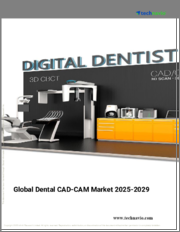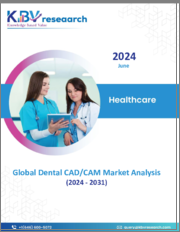
|
시장보고서
상품코드
1410035
세계 치과용 CAD/CAM 시장 예측(2023-2028년)Dental CAD/CAM Market - Forecasts from 2023 to 2028 |
||||||
치과용 CAD/CAM 시장은 2021년 16억 2,100만 달러에서 2028년에는 25억 7,400만 달러까지 CAGR 6.83%로 성장할 것으로 예측됩니다.
치과용 CAD/CAM은 컴퓨터 지원 설계와 제조 기술을 통합하여 치과 의료에 혁명을 가져옵니다. 치과 복구 프로세스의 정확성과 효율성을 향상시킵니다. 치과용 CAD/CAM 기술의 최종 사용자에게는 치과 병원, 진료소, 치과 기공소 등이 포함되어 CAD/CAM 시스템의 고급 기능을 통해 치과 처치의 강화에 도움이 되고 있습니다. 치과 진료소와 클리닉의 확대는 치과용 CAD/CCAM 시장의 성장을 가속하는 중요한 요인입니다.
치과 질환의 유병률 상승이 치과용 CAD/ CAM 시장의 성장을 뒷받침
치과용 CAD/CAM 기술은 정밀하고 맞춤형 솔루션을 제공할 수 있으므로 치과 질환을 치료하는 데 널리 사용됩니다. 치과용 CAD/CAM 기술을 통해 치과의사는 충치, 치주병, 치아 손실 등의 증상을 정확하게 진단하고 치료 계획을 세울 수 있습니다. 구강 위생의 습관이 나쁘고, 고령화 사회와 함께 치과 의료에의 액세스가 불충분하기 때문에 치과 질환의 유병률이 증가하고 있어, 고급 치과용 CAD/CAM 기술에 대한 수요가 높아지고 있습니다. 2022년 세계보건기구(WHO)의 보고에 따르면 세계 약 20억 명의 사람들이 영구 치아의 우식을 앓고 있으며, 약 5억 1,400만 명의 어린이가 유치의 우식을 경험하고 있다고 합니다.
치과용 CADCAM의 급속한 기술 진보가 시장 성장을 견인
치과용 CAD/CAM 시장은 CAD/CAM 시스템의 눈부신 기술 진보에 의해 크게 성장하고 있습니다. 이러한 진보에는 고정밀 구강 스캔, 향상된 소프트웨어 알고리즘, 고속 밀링 머신 개발 등이 포함되어 있으며, 이 모든 것이 CAD/CAM 프로세스의 전반적인 효율성과 정확성을 크게 향상시켰습니다. 그 결과, 치과 진료소나 치과기공소는 워크플로우와 치료 성과를 향상시키기 위해 CAD/CAM 시스템의 채용을 늘리고 있습니다. 예를 들어 3Shape는 2022년 9월 치과 진료의 디지털화를 간소화하기 위한 최첨단 구강 스캐너인 TRIOS 5 Wireless를 출시했습니다.
치과 진료 개선은 치과용 CAD/CAM 시장의 확대를 촉진합니다.
치과기공소에서는 CAD/CAM 시스템을 이용하여 환자의 치아를 디지털 스캔하고, 보철물을 설계하고, CAD/CAM 머신을 사용하여 그들을 제작합니다. 이 기술은 작업 흐름을 간소화하고 치료 시간을 단축하며 치과 수복물의 정확성과 품질을 향상시킵니다. 치과 산업은 현재 전략적 인수와 함께 심미 치과 치료 및 수리 치과 치료 모두 수요가 급증하면서 현저하게 확대되고 있습니다. 예를 들어 2020년 3월 세계 투자 회사인 Carlyle Group은 CAD/CAM 소프트웨어 제공업체인 'Global Holdings GmbH'를 Align Technology, Inc.에 매각하기로 합의했습니다. 이 거래는 디지털 덴티스트리의 포트폴리오를 확장하는 Align Technology, Inc.의 전략적 초점을 돋보이게 합니다.
아시아태평양이 시장 리더가 될 것으로 예상
아시아태평양은 우식, 치주병, 치아 상실의 유병률 증가로 고도의 치과 수복물에 대한 수요가 높아지고 있기 때문에 치과용 CAD/CAM 시장에서 큰 점유율을 차지할 것으로 예상됩니다. CAD/CAM 기술을 채택하여 치과 전문가는 정확하고 맞춤형 치과 보철물, 크라운, 브리지, 임플란트를 제공함으로써 이 수요를 충족할 수 있습니다.
높은 초기 투자와 운영 비용이 시장 성장을 억제
치과 진료에 CAD/CAM 기술을 도입하려면 하드웨어, 소프트웨어 및 교육을 포함한 많은 초기 투자와 지속적인 유지 보수 및 운영 비용이 필요합니다. 이러한 금전적 장벽은 특히 소규모 치과 진료소 및 예산 제약을 받는 치과 진료소에 있어서 CAD/CAM 기술의 도입에 제약을 가져옵니다. 그 결과, CAD/CAM의 도입에는 비용이 든다는 성질이, 보다 널리 채용되기 위한 중요한 억지력이 되고, 특히 경영 자원이 한정되어 있는 치과 진료소에 있어서는 치과 업계에서 이용하는 데 방해가 되고 있습니다.
회사 제품
- Roland DG CAD/CAM Dental Milling Machines Roland DG CAD/CAM Dental Milling Machines에서 제공하는 DGSHAPE의 DWX 기술은 특히 설치 및 밀링 프로세스를 간소화하도록 설계되었으며 실험실 기술자에게 편안하고 편리한 경험을 제공합니다. 이 밀링 머신은 오래도록 만들어졌으며 신뢰할 수있는 성능을 보장하고 치과 보철물의 생산을 간소화합니다.
- Planmeca PlanCAD Premium: Henry Schein은 광범위한 수복물 및 보철물의 요구를 충족시키는 견고한 설계 소프트웨어 플랫폼인 Planmeca PlanCAD Premium을 제공합니다. 이 종합적인 소프트웨어는 크라운 및 브리지 디자인, 왁스 업, 이동식 부분, 의치 등 다양한 워크 플로우에서 다목적으로 사용할 수 있습니다. 개방형 솔루션 접근 방식으로 Planmeca PlanCAD Premium은 치과 의료 종사자의 다양한 요구 사항을 충족하는 유연성과 적응성을 제공합니다.
목차
제1장 서론
- 시장 개요
- 시장의 정의
- 조사 범위
- 시장 세분화
- 통화
- 전제조건
- 기준년과 예측년의 타임라인
제2장 조사 방법
- 조사 데이터
- 조사 과정
제3장 주요 요약
- 조사 하이라이트
제4장 시장 역학
- 시장 성장 촉진요인
- 시장 성장 억제요인
- Porter's Five Forces 분석
- 업계 밸류체인 분석
제5장 치과용 CAD/CAM 시장 : 제품별
- 소개
- 장치
- 밀링 머신
- 스캐너
- 기타
- 소프트웨어
제6장 치과용 CAD/CAM 시장 : 유형별
- 소개
- 의자 주변 CAD/CAM 시스템
- 랩용 CAD/CAM 시스템
제7장 치과용 CAD/CAM 시장 : 최종 사용자별
- 소개
- 치과 병원 및 클리닉
- 치과기공소
- 기타
제8장 치과용 CAD/CAM 시장 : 지역별
- 소개
- 북미
- 미국
- 캐나다
- 멕시코
- 남미
- 브라질
- 아르헨티나
- 기타
- 유럽
- 영국
- 독일
- 프랑스
- 스페인
- 기타
- 중동 및 아프리카
- 사우디아라비아
- 아랍에미리트(UAE)
- 이스라엘
- 기타
- 아시아태평양
- 일본
- 중국
- 인도
- 한국
- 인도네시아
- 태국
- 기타
제9장 경쟁 환경과 분석
- 주요 기업과 전략 분석
- 시장 점유율 분석
- 합병, 인수, 합의 및 협업
제10장 기업 프로파일
- Roland DGA
- Henry Schein
- ZFX Dental
- 3M India
- Patterson Dental
- Alien Milling Technologies
- Benco Dental
- Confident Dental Equipments Private Limited
- UP3D
The dental CAD/CAM market is expected to grow at a CAGR of 6.83% from US$1.621 billion in 2021 to US$2.574 billion in 2028.
Dental CAD/CAM revolutionizes dentistry by integrating computer-aided design and manufacturing techniques. It enhances the precision and efficiency of dental restoration processes. The end-users of dental CAD/CAM technology include dental hospitals, clinics, and dental laboratories which benefit from the advanced capabilities of CAD/CAM systems to enhance their dental procedures. The expanding dental practices and clinics are a key factor propelling the growth of the dental CAD/CCAM market.
Rising prevalence of dental disorders drives the dental CAD/CAM market growth.
Dental CAD/CAM technology is extensively used in the treatment of dental disorders due to its ability to provide precise and customized solutions. It allows dentists to accurately diagnose and plan treatment for conditions such as dental caries, periodontal diseases, and tooth loss. Poor oral hygiene habits, and, inadequate access to dental care coupled with an aging population have increased dental disorders prevalences, thus bolstering the demand for advanced dental CAD/CAM technologies. According to the World Health Organization (WHO) report of 2022, approximately 2 billion individuals worldwide were affected by dental caries in their permanent teeth, while around 514 million children experience caries in their primary teeth.
Rapid technological advancements in dental CADCAM Drive growth in the market
The dental CAD/CAM market has experienced significant growth, largely driven by remarkable technological advancements in CAD/CAM systems. These advancements include the development of highly precise intraoral scans, enhanced software algorithms, and faster milling machines, all of which have substantially improved the overall efficiency and accuracy of the CAD/CAM process. Consequently, dental practices and laboratories have increasingly adopted CAD/CAM systems to take enhance their workflow and outcomes. For instance, in September 2022, 3Shape launched TRIOS 5 Wireless, a cutting-edge intraoral scanner that aims to simplify the digitalization of dental practices.
Improving dental practices drives the dental CAD/CAM market expansion.
Dental laboratories utilize CAD/CAM systems to digitally scan patients' teeth, design prosthetics, and fabricate them using CAD/CAM machines. This technology streamlines the workflow, reduces treatment time, and improves the accuracy and quality of dental restorations. The dental industry is currently witnessing remarkable expansion, driven by a surge in the demand for both cosmetic and restorative dental procedures, alongside strategic acquisitions. For instance, in March 2020, Global investment firm Carlyle Group agreed to sell its CAD/CAM software provider "Global Holdings GmbH" to Align Technology, Inc. This transaction highlights Align Technology's strategic focus on expanding its digital dentistry portfolio.
Asia-Pacific is anticipated to be the market leader.
Asia-Pacific will hold a significant share of the dental CAD/CAM market due to the growing prevalence of dental caries, periodontal diseases, and tooth loss which has propelled the demand for advanced dental restorations. The adoption of CAD/CAM technology allows dental professionals to meet this demand by providing accurate and customized dental prosthetics, crowns, bridges, and implants.
High initial investment and operational costs restrain market growth.
The implementation of CAD/CAM technology in dental practices necessitates a substantial initial investment encompassing hardware, software, and training, along with ongoing maintenance and operational expenses. These financial barriers pose limitations on the adoption of CAD/CAM technology, particularly for smaller dental practices or those constrained by budgetary constraints. As a result, the cost-intensive nature of CAD/CAM implementation becomes a significant deterrent for wider adoption, hindering its accessibility in the dental industry, especially for practices with limited resources.
Key Developments
- February 2023: ZimVie introduced the RealGUIDE CAD and FULL SUITE software modules as part of their digital dentistry platform, enabling precise and advanced restorative design and manufacturing. The CAD module streamlines digital workflows for restorative procedures, featuring a user-friendly interface that guides users and provides a generic design template as a starting point. Through the utilization of new free-form tools, users can then extensively customize and refine the design, ensuring detailed and personalized results during the design process.
- March 2020: Align Technology, Inc. completed the acquisition of Exocad Global Holdings GmbH, a prominent player in the dental CAD/CAM software market. This strategic acquisition strengthens Align's digital platform by incorporating Exocad's advanced technology, which caters to restorative requirements within a comprehensive end-to-end digital workflow.
Company Products
- Roland DG CAD/CAM Dental Milling Machines: Roland DGA offers Roland DG CAD/CAM Dental Milling Machines, which are known for their durability and efficiency in milling various dental prosthetic materials. DGSHAPE's DWX technology is specifically designed to simplify the setup and milling process, providing lab technicians with a more comfortable and convenient experience. These milling machines are built to last, ensuring reliable performance and streamlining the production of dental prosthetics.
- Planmeca PlanCAD Premium: Henry Schein offers the Planmeca PlanCAD Premium, a robust design software platform that caters to a wide range of restorative and prosthetic needs. This comprehensive software provides a full spectrum of indications, allowing for versatile use in various workflows, including crown and bridge designs, wax-ups, removable partials, and complete dentures. With its open solution approach, Planmeca PlanCAD Premium offers flexibility and adaptability to meet the diverse requirements of dental professionals.
Segmentation
- By Product
Equipment
- Milling Machines
- Scanners
- Other
Software
By Type
- Chair-side CAD/CAM Systems
- Laboratory CAD/Cam Systems
By End-User
- Dental Hospitals & Clinics
- Dental Laboratories
- Others
By Geography
- North America
- United States
- Canada
- Mexico
- South America
- Brazil
- Argentina
- Others
- Europe
- United Kingdom
- Germany
- France
- Spain
- Others
- Middle East and Africa
- Saudi Arabia
- UAE
- Israel
- Others
- Asia Pacific
- Japan
- China
- India
- South Korea
- Indonesia
- Thailand
- Others
TABLE OF CONTENTS
1. INTRODUCTION
- 1.1. Market Overview
- 1.2. Market Definition
- 1.3. Scope of the Study
- 1.4. Market Segmentation
- 1.5. Currency
- 1.6. Assumptions
- 1.7. Base, and Forecast Years Timeline
2. RESEARCH METHODOLOGY
- 2.1. Research Data
- 2.2. Research Process
3. EXECUTIVE SUMMARY
- 3.1. Research Highlights
4. MARKET DYNAMICS
- 4.1. Market Drivers
- 4.2. Market Restraints
- 4.3. Porter's Five Force Analysis
- 4.3.1. Bargaining Power of Suppliers
- 4.3.2. Bargaining Power of Buyers
- 4.3.3. Threat of New Entrants
- 4.3.4. Threat of Substitutes
- 4.3.5. Competitive Rivalry in the Industry
- 4.4. Industry Value Chain Analysis
5. DENTAL CAD/CAM MARKET, BY PRODUCT
- 5.1. Introduction
- 5.2. Equipment
- 5.2.1. Milling Machines
- 5.2.2. Scanners
- 5.2.3. Others
- 5.3. Software
6. DENTAL CAD/CAM MARKET, BY TYPE
- 6.1. Introduction
- 6.2. Chair-side CAD/CAM Systems
- 6.3. Laboratory CAD/CAM Systems
7. DENTAL CAD/CAM MARKET, BY END-USER
- 7.1. Introduction
- 7.2. Dental Hospitals & Clinics
- 7.3. Dental Laboratories
- 7.4. Others
8. DENTAL CAD/CAM MARKET, BY GEOGRAPHY
- 8.1. Introduction
- 8.2. North America
- 8.2.1. United States
- 8.2.2. Canada
- 8.2.3. Mexico
- 8.3. South America
- 8.3.1. Brazil
- 8.3.2. Argentina
- 8.3.3. Others
- 8.4. Europe
- 8.4.1. United Kingdom
- 8.4.2. Germany
- 8.4.3. France
- 8.4.4. Spain
- 8.4.5. Others
- 8.5. Middle East and Africa
- 8.5.1. Saudi Arabia
- 8.5.2. UAE
- 8.5.3. Israel
- 8.5.4. Others
- 8.6. Asia Pacific
- 8.6.1. Japan
- 8.6.2. China
- 8.6.3. India
- 8.6.4. South Korea
- 8.6.5. Indonesia
- 8.6.6. Thailand
- 8.6.7. Others
9. COMPETITIVE ENVIRONMENT AND ANALYSIS
- 9.1. Major Players and Strategy Analysis
- 9.2. Market Share Analysis
- 9.3. Mergers, Acquisitions, Agreements, and Collaborations
10. COMPANY PROFILES
- 10.1. Roland DGA
- 10.2. Henry Schein
- 10.3. ZFX Dental
- 10.4. 3M India
- 10.5. Patterson Dental
- 10.6. Alien Milling Technologies
- 10.7. Benco Dental
- 10.8. Confident Dental Equipments Private Limited
- 10.9. UP3D



















